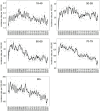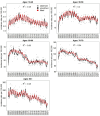Age-dependent seasonality in the incidence of stroke: A 21-year population-based study
- PMID: 38174544
- PMCID: PMC11318438
- DOI: 10.1177/23969873231223031
Age-dependent seasonality in the incidence of stroke: A 21-year population-based study
Abstract
Introduction: Seasonality in the incidence of stroke has been examined in numerous studies, yet data on whether it differs with age are limited. To fill this gap, we utilized a largescale dataset from Israel.
Patients and methods: We retrieved data of all hospitalizations for ischemic stroke (IS), transient ischemic attack (TIA) and intra cerebral hemorrhage (ICH) from 2000 to 2020. We maintained separate datasets for IS/TIA and ICH, divided into five age groups: 18-49, 50-59, 60-69, 70-79, and 80+. We modeled the monthly incidence using a generalized additive model. The seasonal effect was defined by the rate ratio (RR) of each month compared to the annual mean.
Results: The analysis included 317,586 and 23,789 events of IS/TIA and ICH respectively. We found an interaction between age and seasonality, accounting for a phase shift with age in the seasonal pattern of IS/TIA incidence. For cases under 70 years, the peak was during summertime and the RRs increased with decreasing age, reaching 1.11 (95% CI 1.09-1.13) at the youngest age group. In contrast, among the elderly, a winter peak was observed and the RRs increased with age to 1.07 (95% CI 1.06-1.08) at the oldest age group. For ICH, a winter/autumn peak was identified and the RRs increased with age to 1.20 (95% CI 1.16-1.24).
Conclusions: Our finding of age-dependent seasonal patterns in the occurrence of stroke, suggests closer monitoring of cardiovascular risk factors during wintertime among elderly individuals. The mechanism governing the seasonal phase shift with age in IS/TIA incidence, requires further investigation.
Keywords: Stroke; ischemic stroke; seasonal variation; seasonality; transient ischemic attack.
Conflict of interest statement
Declaration of conflicting interestsThe author(s) declared no potential conflicts of interest with respect to the research, authorship, and/or publication of this article.
Figures




References
-
- Koton S, Schneider AL, Rosamond WD, et al.. Stroke incidence and mortality trends in US communities, 1987 to 2011. JAMA 2014; 312: 259–268. - PubMed
-
- Ekker MS, Verhoeven JI, Vaartjes I, et al.. Stroke incidence in young adults according to age, subtype, sex, and time trends. Neurology 2019; 92: e2444–e2454. - PubMed
-
- Ranganai E, Matizirofa L. An analysis of recent stroke cases in South Africa: trend, seasonality and predictors. S Afr Med J 2020; 110: 92–99. - PubMed
-
- Kurtz P, Bastos LS, Aguilar S, et al.. Effect of seasonal and temperature variation on hospitalizations for stroke over a 10-year period in Brazil. Int J Stroke 2021; 16: 406–410. - PubMed
MeSH terms
LinkOut - more resources
Full Text Sources
Medical
Miscellaneous

